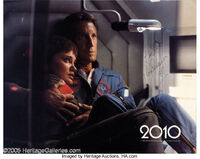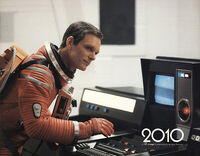2010: The Year We Make Contact is a 1984 film based on Arthur C. Clarke's novel 2010: Odyssey Two, with Kubrick's blessing.[1] It is a sequel to 2001: A Space Odyssey.
Synopsis[]
Nine years after the Discovery's travel to Jupiter, a joint Soviet-American crew is heading for the massive gas planet to find out what happened to the Discovery and its crew. Meanwhile David Bowman, now reborn as an Energy Being, is helping the extraterrestrials who created the Monoliths with scouting Jupiter and its moons for primitive lifeforms, hopefully finding one that has potential to turn sentient.[1]
Plot[]
It is nine years after the mysterious failure of the Discovery mission to Jupiter in 2001, which resulted in the deaths of four astronauts and the disappearance of David Bowman; blamed for the fiasco, Dr. Heywood Floyd resigned his position as head of the National Council of Astronautics.
While an international dispute causes tension between the United States and the Soviet Union, both nations prepare space missions to determine what happened to the Discovery; the Soviet spacecraft Leonov will be ready before the American spacecraft Discovery Two, but the Soviets need American astronauts to help board the Discovery and investigate the malfunction of the ship's sentient computer, HAL 9000, which caused the disaster. The US government agrees to a joint mission when it is determined that Discovery will crash into Jupiter's moon Io before Discovery Two is ready. Floyd, along with Discovery designer Walter Curnow and HAL 9000's creator Dr. Chandra, joins the Soviet mission.
Upon arriving at Jupiter, the crew detect signs of life on Jupiter's seemingly barren moon Europa. They send an unmanned probe down to Europa to investigate the unusual readings, but just as it finds the source, a mysterious energy burst destroys the probe and its data. The "burst" then flies toward Jupiter. The Soviets believe the burst was simply electrostatic build-up, but Floyd suspects it was a warning to stay away from Europa.
After surviving a dangerous braking maneuver around Jupiter's upper atmosphere, the Leonov crew find the abandoned Discovery floating in space. Curnow reactivates the ship and Chandra restarts HAL, who had been deactivated by Bowman before he disappeared. Also nearby is the giant alien monolith that the Discovery was originally sent to investigate. Cosmonaut Max Brailovsky travels to the monolith in an EVA pod, at which point the Monolith briefly opens with a burst of energy, sending Max's pod spinning off into space. On Earth, David Bowman, now an incorporeal being that exists inside the Monolith, appears on his wife's television screen to tell her goodbye, and then visits his terminally ill mother just before she dies.
Aboard the Discovery, Dr. Chandra discovers the reason for HAL's malfunction: The National Security Council had ordered HAL to conceal from the Discovery's crew the fact that the mission was about the Monolith; this conflicted with HAL's basic programming of open, accurate processing of information, causing him to suffer the computer equivalent of a paranoid mental breakdown. Although the order bears his signature, Floyd angrily denies any knowledge of the NSC's actions.
Back on Earth, when tensions between the United States and the Soviet Union heighten to a virtual state of war, Floyd, Curnow and Chandra are ordered to leave the Leonov and move to the Discovery, with all but emergency communication between the the two ships forbidden. Both crews plan to leave Jupiter separately when a launch window opens in several weeks' time, but Bowman appears to Floyd and says it is paramount that everyone leave within two days. Stunned by Bowman's appearance, Floyd returns to the Leonov to confer with Captain Tanya Kirbuk, who remains skeptical until the Monolith suddenly disappears. Since neither ship can reach Earth with an early departure, they work together using the Discovery as a booster rocket for the Leonov, though it will mean the destruction of the Discovery and HAL's destruction.
As preparations continue, they discover a black spot on Jupiter's surface; the spot is actually an exponentially growing group of monoliths that are shrinking Jupiter's volume, increasing the planet's density, and modifying its chemical composition. This convinces the two crews that they must leave soon. Since neither ship could reach Earth with an early departure, they work together using the Discovery as a booster rocket for the Leonov, though it will mean the destruction of the Discovery- and HAL himself.
Initially uninformed about the true purpose of the operation, HAL suggests to Chandra to stop the launch and remain to study Jupiter's conversion. When Chandra finally tells HAL the truth, he willingly continues the countdown to save the humans. The Monoliths engulf Jupiter, causing nuclear fusion that transforms the planet into a small star. Discovery is consumed in the blast after the Leonov breaks away to safety. Just before the Discovery is engulfed, Bowman's voice is heard once again as he speaks to HAL and tells him that they will soon be together after he transmits a message to Earth:
ALL THESE WORLDS
ARE YOURS EXCEPT
EUROPA
ATTEMPT NO
LANDING THERE
USE THEM TOGETHER
USE THEM IN PEACE
The star's miraculous appearance inspires American and Soviet leaders to seek peace. Europa gradually transforms from an icy wasteland into a humid jungle covered with plant life. A Monolith stands in the primeval Europan swamp, waiting for intelligent life forms to evolve.
Cast[]
- Roy Scheider as Dr. Heywood Floyd
- John Lithgow as Dr. Walter Curnow
- Helen Mirren as Commander Tanya Kirbuk
- Bob Balaban as Dr. R. Chandra
- Keir Dullea as Dave Bowman
- Douglas Rain as HAL 9000 (voice)
- Candace Bergen as SAL 9000 (credited as Olga Mallsnerd)
- Madolyn Smith Osbourne as Caroline Floyd
- Dana Elcar as Dmitri Moisevitch
- Taliesen Jaffe as Christopher Floyd
- James McEachin as Victor Milson
- Mary Jo Deschanel as Betty Fernandez
- Elya Baskin as Dr. Maxim Brajlovsky
- Saveli Kramarov as Dr. Vladimir Rudenko
- Oleg Rudnik as Dr. Vasili Orlov
- Natasha Shneider as Irina Yakunina
Gallery[]
Trivia[]
- Stanley Kubrick had all models and sets from 2001: A Space Odyssey destroyed to prevent their reuse, thus the model of the spaceship Discovery had to be constructed from pictures.
Difference from novel[]
- In the novel, HAL repeats the words: "All these world are yours except Europa. Attempt no landings there." The movie adds the words "Use them together. Use them in peace."
References[]
- ↑ 1.0 1.1 "Literature / The Space Odyssey Series". TV Tropes. Retrieved on May 17, 2019.
External links[]
- 2010: The Year We Make Contact at Wikipedia
- 2010: The Year We Make Contact at IMDb



















